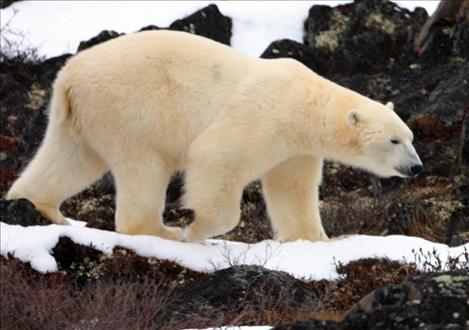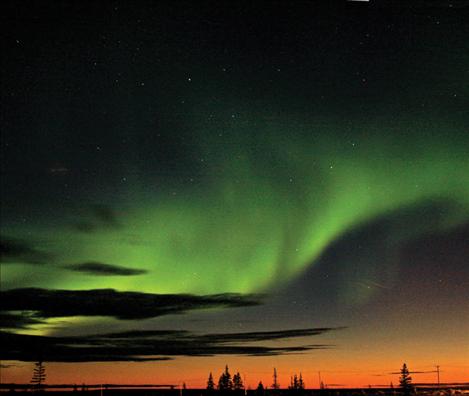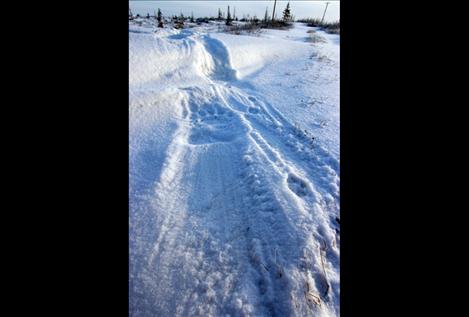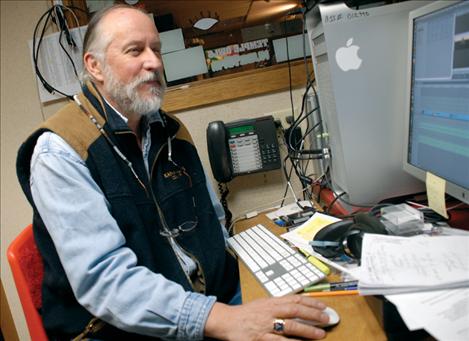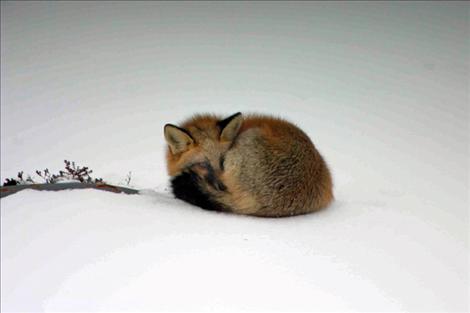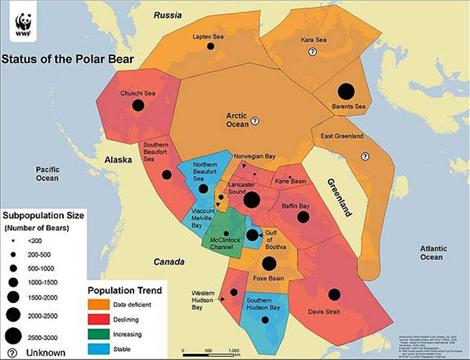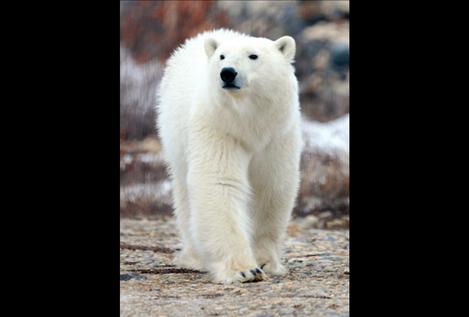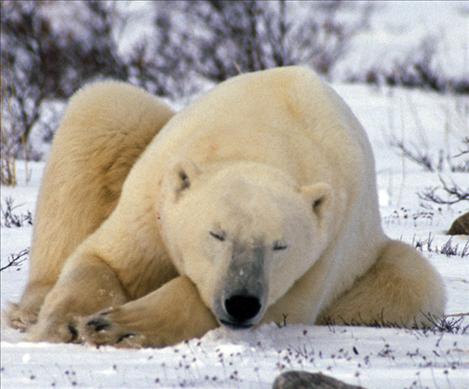Salish Kootenai College professor documents polar bears in Churchill
Hey savvy news reader! Thanks for choosing local.
You are now reading
1 of 3 free articles.
Churchill, Manitoba, Canada, bills itself as the “polar bear capital of the world.” Situated on Hudson Bay, Churchill offers a perfect place for polar bears to gather to wait for the ice to freeze, usually in November, so they can go out on the ice to hunt ringed seals, their favorite food. The massive bears, which can weigh up to a ton, go out on the ice and remain there until the ice melts.
As a photographer and videographer, Frank Tyro, Media/KSKC Director at Salish Kootenai College, has visited the small town 33 times, beginning in 1984, with his most recent trip in November 2012. He is a volunteer staff member of Great Bear Foundation, a 501(c)(3) nonprofit organization dedicated to the conservation of the eight species of bears and their habitat around the world.
Tyro’s first Churchill trip came about because Bob Claiborne, a biology instructor at SKC, had known Chuck Jonkel at the University of Montana. Jonkel did the first systematic, scientific research on polar bears, and that research took place in Churchill.
It was one of those “Gee, it would be nice to take someone to take photos and video,” moments, Tyro said. That first trip was an interesting mix of people, with three SKC students, graduate students from Missoula, and Duff Garrish, an area counselor, and his wife.
One SKC student was Bill Swaney, who is now director of SKC’s Natural Resources Department, and another was Jan Lozar, who was working on a giardia study. Lozar was one of the few students allowed into the “bear jail” in Churchill, and she collected fecal samples for her study. Polar bears are in “walking hibernation,” napping and hanging out on the shores of Hudson Bay waiting for the ice to freeze. Those that amble into the town of Churchill are warned by guards who shoot firecrackers. Bears that return again may wind up in the bear jail, where they are given water and may be detained for up to 30 days before they are relocated by helicopter.
It’s not cruel to the bears, because they’re not eating anyway. Churchill does not want to be a food source in a bear’s mind.
“I was definitely excited,” Tyro said about the first trip.
To prepare, Claiborne gave all the travelers a big packet of information to read, and Tyro also saw the National Geographic film, “Polar Bear Alert.”
“Polar Bear Alert” was one of the first exploitative wildlife films,” Tyro said, since it pictured hysterical people worried that polar bears would break down the doors to their homes.
“The film really portrayed (Churchill) as a town in fear of its life,” he said.
When he got to Churchill, Tyro learned that portion of the film hadn’t even been shot in Churchill, but in a little village outside of Churchill.
“The people weren’t running around in fear of polar bears,” he added.
That first year Tyro’s group only saw bears through spotting scopes, but they did see other wildlife, such as arctic and red foxes.
“I don’t ever remember being scared,” Tyro said.
The SKC group stayed at the Churchill Northern Studies Center, then a rather rustic building with outhouses and uneven heating.
One morning, Tyro woke to find 3 inches of snow had blown all over the room through a tiny crack in the wall.
Eventually the center moved to the “Rocket Range,” a one-time USA military base with the longest airstrip in Canada. Turned over to the Canadian government, the range launched 18-to-25-foot low-altitude sub-orbital rockets, such as Auroras, to study the aurora borealis or climate.
Now this center is housed in a $21 million, Leeds gold-certified building, which means it’s environmentally friendly, energy efficient and uses the latest and best technology.
No more outhouses, now the center has composting toilets, Tyro said.
The first leg of the trip to Churchill was “just about exactly 1,000 miles from Pablo to a town in Manitoba called The Pas,” Tyro said. The group caravanned there, and then boarded the VIA railway for another 600 miles.
“You can’t drive to Churchill,” Tyro said.
The road goes within 150 miles, but a combination of muskeg, a wet bog of sphagnum moss and sedges, tundra and permafrost make road construction dicey.
It’s possible to fly into Churchill, Tyro said.
Jonkel doesn’t even like the word “tourist,” Tyro explained, and believes all people should be “travelers” and savor the journey.
Since the first trips to Churchill, Tyro campaigned to transport the Arctic ecology field trip members on a bus rented from SKC. Tyro and another Great Bear Foundation staffer have commercial driver’s licenses and drive. Now, instead of driving straight through, they stay in Swift Current, Alberta, one night on the drive up and in Taber, Alberta, on the way back to Pablo.
After 33 trips, people ask Tyro why he keeps going back.
“I enjoy people seeing their first bear, seeing their reactions to the cold,” he explained.
Polar bears are massive, with the largest one ever tagged weighing in at 2,200 pounds. The biggest one Tyro and the SKC groups have seen weighed about 1,200 to 1,300 pounds.
In November, when Tyro normally heads north, the sun comes up at 8:30 a.m. and sets at 4 p.m. so he and Jonkel lecture to morning and evening classes, when they are not out viewing the bears.
Tyro has also made summer trips and said it’s a different world — green with a profusion of berries and all the wildlife that comes to feast on the berries.
During trips, Tyro’s job is to drive the bus and carry the shotgun, loaded with three “cracker shots,” which are designed to scare the bear, a load of .00 buckshot and a slug. The slug is a last-ditch effort.
“We have had about three situations where we had to fire crackers,” Tyro said.”
Over the years, Tyro has seen big changes in the climate, changes in the bears and changes in the way the bears are treated.
When the military was in the area, they used polar bears for artillery practice.
“They were just a nuisance,” Tyro said.
Now the bears are protected.
A tourism business involving the polar bears began when a Churchill man bought wrecked or used fire trucks with huge flotation tires, transformed them into 4-wheel-drive “tundra buggies” and set up a tourist business. The military had laid down gravel roads on the tundra, muskeg and permafrost, and this Churchill entrepreneur and then another received permission from the Canadian government to drive on the gravel to provide tours of the polar bears without destroying the fragile plants in the ecosystem.
The climate change has been very apparent to Tyro.
“The farther north you go, the more obvious it is,” he said.
Tyro gave examples, such as robins appearing in Barrow, Alaska, where people had never seen one before, and freezing rain on Baffin Island, coating everything in a 2-to-3-inch ice shell, causing caribou to die because they couldn’t break through to eat.
Also, “freeze-up” sometimes is delayed by two weeks or more, and when the ice melts may be two weeks earlier, so the great white bears have at least a month shorter hunting season.
Tyro remembers seeing bears just “rolling fat, and now we see bears with ribs showing.”
He also said infant mortality is up; weaning weight is down: and the numbers of bears is down.
Tyro said 2012 was a good year for polar bears, since break-up was late and freeze-up was Nov. 15.
Ringed seals have their babies on the ice in March and then build an egglo, a mound of snow on top of the ice. Seal pups can’t go into the water for three to four weeks, since their coats are not waterproof, so they are deposited in the egglo to keep warm and safe while the mother seals are off fishing.
At about the same time, mother polar bears begin emerging from their maternity dens.
They see the seal pups as “15 pounds of butterfat,” according to Tyro, and bash in the egglos to grab the seal pups.
The ice cap in Alaska used to be 10 miles off shore, Tyro said. Mother polar bears and their cubs would swim to the ice to hunt seals. Now the ice cap is 100 miles offshore, and many cubs are drowning, since it’s a much longer swim.
Ice reflects the heat pf the sun, Tyro said, and water absorbs the heat. Whether or not the polar bears can adapt is debatable.
“(Jonkel) is a bit of a pessimist,” Tyro said.
Another big worry is the possibility of an oil spill. Oil would absorb the sun’s heat and cause an even larger area to melt out.
The variety of wildlife in Churchill is amazing, Tyro said, with ptarmigans, Arctic hares, polar bears, black bears, brown bears, Arctic foxes, silver foxes, red foxes and cross foxes.
There are also kermode bears, the white phase of a black bear. One of out 10 bears in Churchill is a kermode, or a spirit bear, Tyro said.
After break-up, Tyro said many of the big male bears go east and south of Churchill to the Owl River denning area and dig summer dens. Ideally, a summer den is next to a pond with some ice for coolness and to avoid the bugs. Spending a lot of time in their dens, the males also swim to cool off, but mostly use as little energy as possible until it’s time to hunt seals.
The mother bears head back to their maternity dens at this time.
Tyro’s latest trip was in November of 2012.
“I just love it,” Tyro said of Churchill. “Just to see the people and renew acquaintances, to have that opportunity to observe the changes over the years.”
“The other thing,” Tyro grinned. “That’s where I met my wife, in 1988.”
For more information on polar bears and arctic ecology trips, visit the Great Bear Foundation website at www.greatbear.org.















